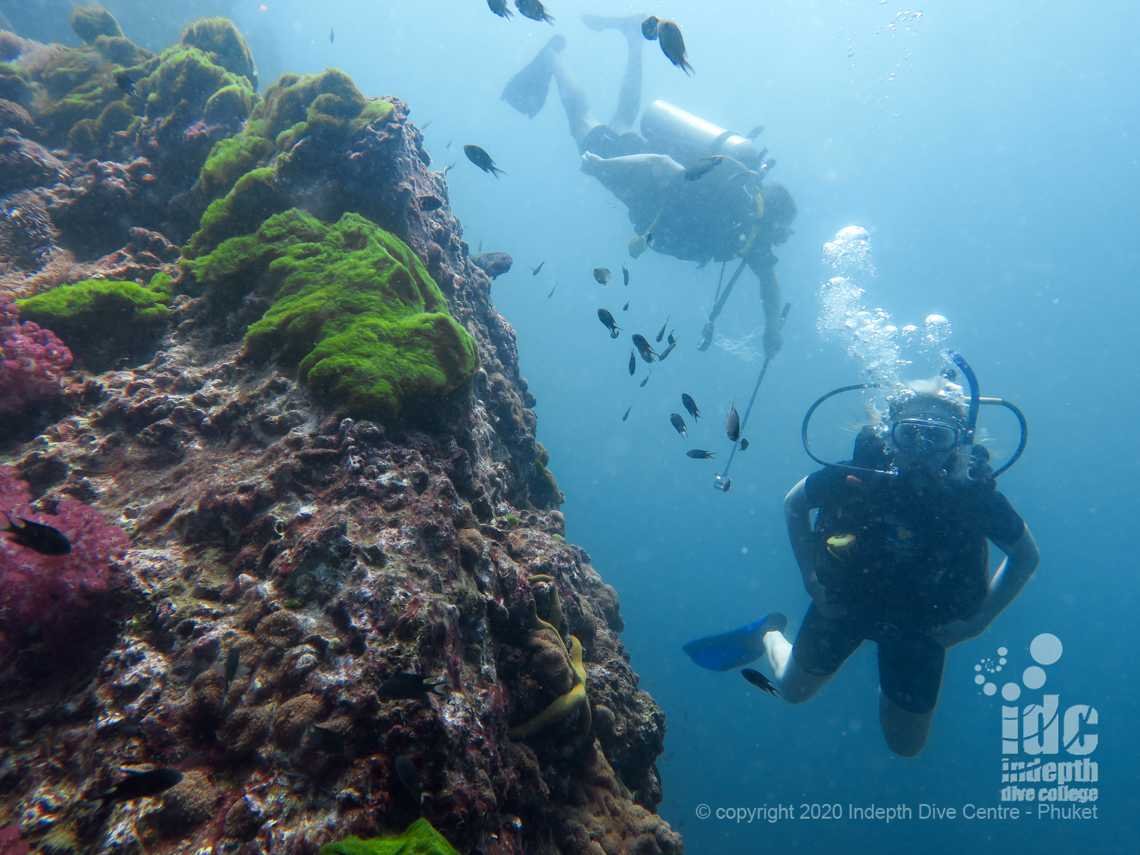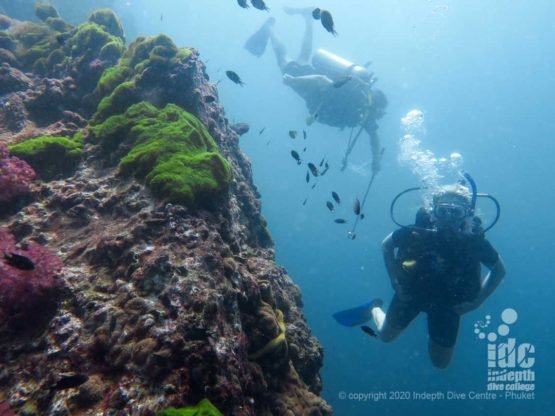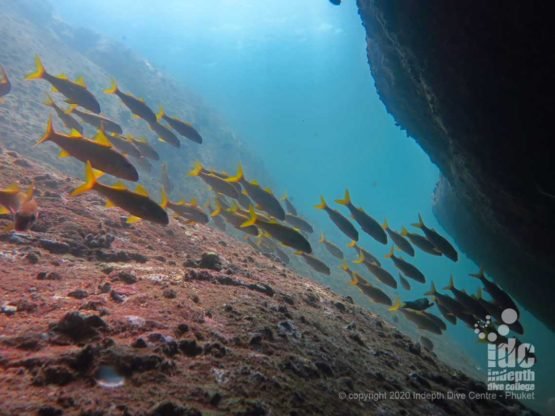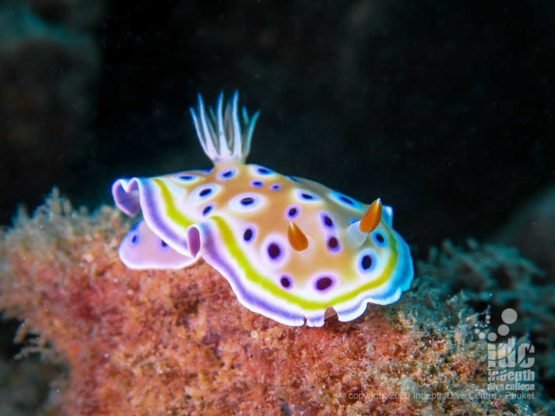
Similan Island No. 4: Chinese Wall
Located on the Southern tip of Island No. 4, Chinese Wall is rarely dived now-a-days and in a way has become a “secret dive site” known only to us “old-timers”
At the time of writing there is 1 mooring line on this dive site secured to a large concrete block in the sand at a depth of around 20m. Therefore, it is recommended that you use the mooring line for decent, or at least as a reference point. Now, to start the dive we would normally descend and head directly South. So all you need to do is follow the large chain of rocks that someone once thought resembles the Great Wall of China. And YES you guessed it, that is how this dive site got it’s name.
Here in the sand you can expect to find Kuhl / Blue Spotted Stingrays, Gobies and hundreds of Garden Eels. And then if you head West into the bay, you will find a large field of hard corals. Some of our favourites are the Table Corals, Staghorn Corals and some great Finger Corals.
In addition, if you want to dive Phuket before you Liveaboard we can arrange a Phuket Diving Day Trip for you. Not only will you get back into Dive Mode, but we can also introduce to some of the corals and marine life you will encounter on The Similan Islands dive sites.
Remember; Chinese Wall is usually a great dive site to spot both the Green & Hawksbill Turtle ...


Have you ever wanted to Dive the Great Wall of China?
To start the dive, we would enter the water from the dive platform. You will see the boulders begin just above the surface and continue down underwater to a depth of almost 30m. However, as there is a mooring line it is recommended that you use it.
Once at the bottom of the mooring line you will find yourself at depth of around 20m. Now if you look around carefullly, you can sometimes find a Ribbon Eel inbetween the boulders, normally black, with a yellow stripe. Also between the boulders, are more flat sandy areas where there are more Garden Eels and Gobies. This is also a cool place to spot Giant Moray Eels resting between the rocks during the daytime. Moreover, Honeycomb Morays can also be spotted here on occasion.
When looking out from the bottom of the mooring, you will see large granite boulders which continue down to a depth of between 20-25m. However, if you follow these you can reach a depth of at least 50m. As such, please be very careful to follow your dive plan and keep an eye on your depth.
How to dive Chinese Wall
As you get further out onto the large chain of boulders, you will find yourself on The Great wall of China. These boulders create swim-throughs and canyons which can make this Similans dive site a diver's playground. As a bonus, there is a good selection of soft corals with some very large Sea Fans. This dive site is an excellent place for mid-water activity so keep your eyes open. There are large schools of Glass Fish being pursued relentlessly by Trevallies, Tuna, Barracuda, Snappers and Fusiliers. Also in the mid-water, you find the very large Surgeon & Unicorn Fish, similar to those that can be found at Boulder City and Shark Fin Reef.
On top of these, Chinese Wall also has all the various species of Angel Fish you can find in the Andaman Sea. These include the rare Korean Angelfish, in addition to Box Fish, Butterfly Fish and Clown Fish. And there are several different Trigger Fish, including the beautiful Clown Trigger Fish. The Clown Trigger Fish always makes a great photo if you can get close enough. Following that, if you continue South the depth remains at between 20-25m, above the rocks, for quite some way. Consequently, you need to be very aware of your depth and No Decompression Limits / remaining dive time. As such, it is recommended that when your remaining dive time reaches 10 minutes, you should turn around and head back towards shallower water.
BE CAREFUL: As if you do not watch your depth and time, there is a good chance you will go into decompression. This is strongly advised against and is NOT permitted by most Thailand Liveaboard operators.
Can I take a PADI Nitrox Course in The Similans?
As is usual in The Similans, diving on Enriched Air Nitrox (EANx) is a great option. Especially as diving on EANx at these depths, would almost DOUBLE your dive time. If you plan your dive correctly that is. Therefore, if you aren’t already certified as a Nitrox Diver we can easily arrange this for you to take during your trip. So all you need to do is relax, enjoy and double your Dive Time.
Now, in the deeper areas of the dive site, you can spot Leopard Sharks sleeping in the sand. Usually along with the occasional Whitetip and Blacktip Reef Sharks. Also, Manta Rays have also been spotted here, but sightings are rare.
Chinese Wall remains an extremely popular dive site with Rebreather CCR divers. This is due to the amount there is to see here in terms of marine life and marine life diversity. Similarly, the topography is perfect for a 2-3 hour rebreather dives, especially if you are carrying an underwater camera with you.
Please take note that currents on this dive site can be very strong, especially at full or new moon. However there are plenty of rocks for protection, but sometimes divers need to get beneath the current to make any progress. But don't worry, your Dive Guide will brief you carefully on this.
Ending the dive
Especially on this dive site, try not to overexert yourself as can happen if you are not familiar with it. Sometimes it’s easier to abandon the dive rather than try to get back to the shallows. Therefore, always make sure you have a safety marker (SMB or DMSB) so you can be clearly seen by your dive boat. Then as you head back into the shallows, look between the rocks for Cowries, in particular the Tiger Cowrie. There are also plenty of Banded Boxer Shrimps, Cleaner Shrimps as well as Dancing Durban Shrimps. And it is also possible to see the Jann’s Pipefish between the rocks and Multibar Pipefish.
Once you get close to the Island into depths of less than 10m, you will be back in the shallows where the current is normally no longer a problem. All in all this all makes for a very nice end to a dive.
We think this is one of the most beautiful dive sites in the Similans, especially below 20m. At that depth the soft corals and large Sea Fans remain in pristine condition, as very few people dive this dive site.
As VERY FEW dives operators come to this dive site, there is no map in any of the dive books. As such, you can often get the site to completely yourselves ...












